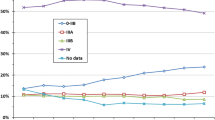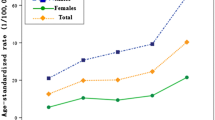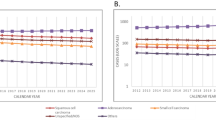A computerized simulation model was developed to evaluate the potential impact of primary and secondary prevention on lung cancer mortality in Japan. The natural history of lung cancer was modeled as a Markovian stochastic process from cancer-free to preclinical, clinical, and finally to terminal states. The increase in mortality rate of lung cancer among males aged 75 to 79 years has been the major force of increase in the total number of lung cancer deaths in Japan. The simulation showed that this tendency would continue until the late 1990s, presumably due to the increase in the proportion of ever-smokers in that cohort, who started smoking at an earlier age than did prior generations. It was shown that the number of lung cancer deaths can be reduced either by smoking cessation or screening programs, and that the reduction is proportional to the increase in the annual smoking-cessation rate and to the annual increment in the screening rate. However, only two to three percent reduction of lung cancer deaths in the year 2001 can be expected when the annual smoking-cessation rate is raised from the current value of 0.46 percent to five percent during the period from 1991 to 2000 or when the screening rate is increased by three percent annually for the same period.
Similar content being viewed by others
References
Statistics and Information Department, Ministry of Health and Welfare. Vital Statistics 1988 Japan, Volume 3. Tokyo: Health and Welfare Statistics Association, 1990: 94–102.
The Bureau of Vital Statistics, Ministry of Health and Welfare. Long term trends in cancer mortality rates from 1995 to 1987 in Japan. Jpn J Clin Oncol 1989; 19: 305–17.
Watanabe S. Why do we need cancer information? Jpn J Clin Oncol 1990; 20: 7–15.
Watanabe S. Cancer morbidity and related problems. In: Suemasu K, ed. Fifth National Cancer Morbidity Survey in Japan 1990. Tokyo: Sougou Igaku Sha, 1990: 9–16 (in Japanese).
Fontana RS, Sanderson DR, Woolner LB, Taylor WF, Miller WE, Muhm JR. Lung cancer screening: The Mayo Program. J Occup Med 1986; 28: 746–50.
Melamed MR, Flehinger BJ. Detection of lung cancer: highlights of the Memorial Sloan-Kettering Study in New York City. Schweiz Med Wschr 1987; 117: 1457–63.
Tockman MS, Levin ML, Frost JK, Ball WC, Stitik FP, Marsh BR. Screening and detection of lung cancer. In: Aisner J, ed. Lung Cancer, Contemporary Issues in Clinical Oncology, New York: Churchill-Livingstone, 1985: 25–40.
Flehinger BJ, Kimmel M, Melamed MR. Natural history of adenocarcinoma-large cell carcinoma of the lung: Conclusions from screening program in New York and Baltimore. JNCI 1988; 80: 337–44.
Oda S. Estimation of smoking rates in Japan by comparing nationwide surveys. J Health Welfare Stat 1990; 37(8): 11–6 (in Japanese).
Tominaga S. Smoking and cancer patterns and trends in Japan. In: Zaridze DG, Peto R, eds. Tobacco: A Major International Health Hazard. Lyon: International Agency for Research on Cancer, 1986: 103–13.
Lubin JH, Blot WJ, Berrino F, et al. Modifying risk of developing lung cancer by changing habits of cigarette smoking. Br Med J 1984; 288: 1953–6.
Ockene JK, Kuller LH, Svendsen KH, Meilahn E. The relationship of smoking cessation to coronary heart disease and lung cancer in the Multiple Risk Factor Intervention Trial (MRFIT). Am J Public Health 1990; 80: 954–8.
Sobue T, Suzuki T, Fujimoto I, et al. Lung cancer risk among exsmokers. Jpn J Cancer Res 1990; 82: 273–9.
Manton KG, Stallard E. Chronic Disease Modelling. London: Charles Griffin & Company, 1988: 134–8.
Doll R, Peto R. Cigarette smoking and bronchial carcinoma: dose and time relationships among regular smokers and lifelong non-smokers. J Epidemiol Community Health 1978; 32: 303–13.
Mizuno S, Akiba S, Hirayama T. Lung cancer risk comparison among male smokers between the ‘Six-prefecture Cohort’ in Japan and the British Physicians’ Cohort. Jpn J Cancer Res 1989; 80: 1165–70.
Lung Cancer Task Force, The Japanese Joint Committee on TNM Classification, and National Cancer Center. TNM Classification of Lung Cancer, 10,334 Cases in 1981 1982 1983. 1988: 62–77, 133–5 (in Japanese).
Suzuki R, Sobue T, Nakayama N, et al. Sensitivity and specificity of lung cancer screening in Osaka. Lung Cancer (Official Journal of the Japan Lung Cancer Society) 1988; 28: 653 (in Japanese).
Statistics and Information Department, Ministry of Health and Welfare. Vital Statistics (1973 through 1987) Japan. Tokyo: Health and Welfare Statistics Association, 1975–89.
Ohtaki M. A model for age-dependence of lung cancer mortality. Bull Biometric Soc Japan 1990; 11: 127–38.
Rogot E, Murray JL. Smoking and causes of death among US Veterans: 16 years of observation. Public Health Rep 1980; 95: 213–22.
Ministry of Health and Welfare. National Health Survery 1980 Japan Tokyo: Kousei Toukei Kyokai, 1980: 24–5 (in Japanese).
US Department of Health and Human Services. Nicotine Addiction. A Report of the Surgeon General Rockville, MD: Office on Smoking and Health, 1988; DHHS Pub. No. (CDC) 88–8406: 565–87.
Dwer T, Pierce JP, Hannam D, Burke N. Evaluation of the Sydney ‘Quit. For Life’ anti-smoking campaign. Part 2. Changes in smoking prevalence. Med J Aust 1986; 144: 344–7.
Matsushita K, Nakamura M, Miyamoto M, Endo S, Oshima A. Evaluation of a community-wide smoking cessation contest: “The First Osaka Quit Contest’. Results from one year follow-up. Jpn J Public Health 1989; 36: 88 (in Japanese).
Author information
Authors and Affiliations
Additional information
This study was supported in part by a grant-in-aid for Cancer Research from the Ministry of Health and Welfare, Japan.
Rights and permissions
About this article
Cite this article
Yamaguchi, N., Tamura, Y., Sobue, T. et al. Evaluation of cancer prevention strategies by computerized simulation model: an approach to lung cancer. Cancer Causes Control 2, 147–155 (1991). https://doi.org/10.1007/BF00056207
Received:
Accepted:
Issue Date:
DOI: https://doi.org/10.1007/BF00056207




